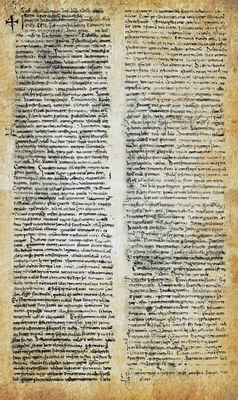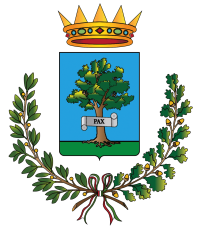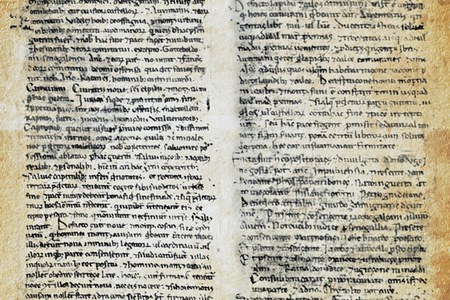The Peace of Polverigi
 In the stormy annals of the Middle Ages in the Marche region, local wars were far more numerous than peace treaties, but one of them, known as "The Peace of Polverigi," had important consequences especially with regards to relations between the Church and local communities. The document was signed on January 18th, 1202, by twenty-six localities of the border district of Ancona, five of which were municipalities with their respective "contadi," that is, with territories still partly controlled by local nobles. The scene of the historic event was the castle of Polverigi, belonging to the defensive circle of the city of Ancona. Polverigi was then a fortified village developed in the 12th century on the hillock overlooking S. Damian's parish church
In the stormy annals of the Middle Ages in the Marche region, local wars were far more numerous than peace treaties, but one of them, known as "The Peace of Polverigi," had important consequences especially with regards to relations between the Church and local communities. The document was signed on January 18th, 1202, by twenty-six localities of the border district of Ancona, five of which were municipalities with their respective "contadi," that is, with territories still partly controlled by local nobles. The scene of the historic event was the castle of Polverigi, belonging to the defensive circle of the city of Ancona. Polverigi was then a fortified village developed in the 12th century on the hillock overlooking S. Damian's parish church
The peace treaty concluded in Polverigi was part of the troubled events of the relationship between the Germanic Empire and the Papacy. In the 12th century Emperor Frederick Barbarossa had succeeded in reducing the District of Ancona and the Committee of Fermo under his authority. After his death in 1190, these territories returned under the rule of the Holy See. However in 1195, Henry VI, Barbarossa's son and successor, entrusted his seneschal, Marcovaldo of Annweiler, with the task of subjugating the District of Ancona and the territory of Fermo, but he achieved little result because in 1197, the year of the emperor's death, most of the localities in the Marches sided with the Church, so that Marcovaldo was forced to leave the Adriatic region in November of the following year. The choice of side of the various localities in the Marche had certainly been prepared by the skillful diplomatic action of the Holy See, that had sought, through oaths, to secure the loyalty of municipalities and castles by granting them wide autonomy and siding with them against the Empire. Also the election as pontiff in 1198 of Innocent III, a staunch advocate of the supremacy of the Roman Church over any other earthly authority, must have played a role in those events. It should be added, however, that the Church did not yet have its own administration or military garrison at this time and that its power was therefore mostly virtual.
It was in August 1198, while Marcovaldo was still in the border district of Ancona, that the first pact (mentioned above) was made between Ancona and Osimo, around which it was formed a vast alliance among localities that will be the signatories of the Peace of Polverigi: Fermo, Civitanova, Macerata, Montelupone, Montesanto, Numana and Castelfidardo. Once Marcovaldo left the scene, other important municipalities such as Jesi, sided with the Church; however, the situation appeared fluid and confused until the early months of 1201, when two opposing leagues were formed: one consisting of the municipalities of greater population sizes such as Fermo, Osimo, Jesi and Fano; the other, led by Ancona and including Sant'Elpidio, Civitanova, Montolmo, Recanati, Castelfidardo, Camerino, Senigallia and Pesaro. It seems that Ancona acted as a protective power for the smaller municipalities fighting against one of the four cities of the first league (e.g., Sant'Elpidio against Fermo). The latter must have been allied just in function anti-Ancona.
The Peace
During 1201 the two leagues stoked various local conflicts, which ceased only at the beginning of 1202, when a peaceful settlement was reached between the sides, that were better outlined than the previous year. This agreement seems to follow the pattern of a letter sent by Pope Innocent III to the Municipality of Osimo a few months earlier, which showed how much the signatory localities now felt bound to the Church.
The peace is solemnly signed by a notarial act in Polverigi on January 18th, 1202. On the one side are Fermo, Torre di Palme, Macerata, Morrovalle, Montelupone, Montesanto (Potenza Picena), Montegranaro, San Giusto (Monte San Giusto), Osimo and its county, Offagna, Jesi and its county, and Monteurbano (locality near Montecassiano). On the other one, Ancona and its county, Camerano, Recanati, Montarice (today the locality belongs to Porto Recanati), Montefano, Castelfidardo, Civitanova, Montecosaro, Sant'Elpidio, Castello di Castro (near Sant'Elpidio, but now disappeared), Montolmo (Corridonia), Senigallia and its county, Pesaro, Fano and its county, and Monte Riario (disappeared, location unknown). By the act they signed, the cities and castles of the two leagues swore not to attack each other and to resolve peacefully various issues that had arisen between them.
The summit was supposed to be quite scenic: Ancona, Osimo and Jesi had sent their respective Podestas accompanied by delegations, Recanati was present with its two Consuls, the other localities were represented by two or three citizens. Very numerous was the ecclesiastical representation: seven bishoprics all located along or near the coast. Although it has sometimes been portrayed as the beginning of the papal power over the border District of Ancona, the Peace of Polverigi marked only a short-lived truce in the often conflicting relationships between localities, feudal lords and Church representatives in the Adriatic region. However, it was the result of a long-term diplomatic action by the Papacy and in this sense it can be said it marked a decisive step forward in the Church's strategy to establish its authority over the border District of Ancona and the territories now recognized as the Marche region.


